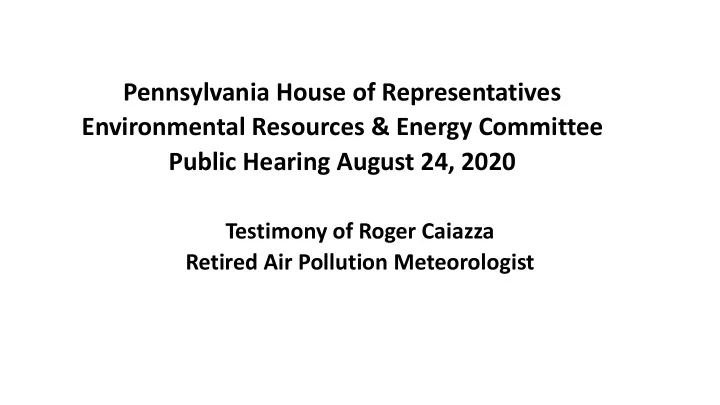

Pennsylvania House of Representatives Environmental Resources & Energy Committee Public Hearing August 24, 2020 Testimony of Roger Caiazza Retired Air Pollution Meteorologist
Roger Caiazza Background • Air pollution meteorologist in electric sector since 1981 • Responsible for pollution monitoring reports and pollution trading reports for electric generating companies • Performed regulatory analysis of numerous emissions trading programs including RGGI • Since retirement I blog at Pragmatic Environmentalist of New York • The opinions expressed in my testimony do not reflect the position of any of my previous employers or any other company I have been associated with, these comments are mine alone.
Carbon Pricing • Attractive theory to let market decide how to make reductions • RGGI is a carbon pricing variation called “cap and dividend” but I call it “cap and tax” • Practical problems reduce attractiveness • Pollution leakage • Lack of power plant control options • Ultimately it is a regressive tax
RGGI’s so called “Success” Story • PA DEP webinar: “ Since 2005, RGGI states have significantly reduced their power sector CO2 pollution” beneath a graphic that indicates that there was a 45% reduction • RGGI Investment Proceeds report: “As a whole, the RGGI states have reduced power sector CO2 pollution over 50% since 2005, while the region’s gross domestic product has continued to grow”. • How much did RGGI actually contribute to those reductions?
RGGI Emissions Analysis • Used emissions data for the period 2005 to 2019 from the Environmental Protection Agency’s Air Markets Program Data website • Data from all RGGI states and Pennsylvania • Unit-level data for operating time, number of months reported, gross load, steam load, SO2, NOx, and CO2 mass, heat input, source category, unit type, primary fuel type and secondary fuel type. • Summarized data by category totals
RGGI & PA Emission Reduction Summary • Emission reductions against 3-year baseline 2006-2008 against last three years 2017-2019 • CO2 Mass (tons) down 33% or 98,247,343 tons • SO2 Mass (tons) down 95% or 1,483,165 tons • NOx Mass (tons) down 82% or 306,997 tons • Gross Load (MWh) down 12% or 45,032,054 MWh • Heat Input (mmBtu) down 23% or 856,239,177 mmBtu
Annual CO2 Emissions from RGGI States & PA by Primary Fuel Type
Possible Reasons for Reductions • Supported by data • Fuel Switching • Older coal units displaced by new efficient natural gas combined cycles • Not supported by data • Add-on controls • Efficiency projects
RGGI Effect on Emissions • RGGI publishes an annual investment proceeds report • Cumulative annual amount invested per year: $ 2,775,635,414 • Avoided CO2 emissions from the investments 3,091,992 tons • Pre-RGGI baseline to last 3 years reduction 98,247,343 tons • That means that for this comparison RGGI is only responsible for 3.3% of the observed reduction • Cost per ton removed is $898
What effect will PA joining RGGI have on global warming? • MAGICC projections for the United States can be pro-rated for PA electric sector emissions (82,798,637 CO2 tons in 2019) • Assume all electric sector emissions are eliminated • Temperature “savings,” of approximately 0.0011 ° C by the year 2050 and 0.0023 ° C by the year 2100 • The projected temperature difference is the same as going down 9 inches • The projected temperature change is the same as going south 0.2 miles • The reductions will be replaced by added 2019 Chinese capacity in 389 days or 153 days if the 2019 capacity and the units under construction are combined.
Pennsylvania vs. . Nine RGGI States 2009-2019 Fuel Fossil Heat SO 2 NOx CO 2 Carbon Generation Rate Intensity RGGI States -22.8% -97.4% -79.8% -41.8% -9.7% -16.5% Pennsylvania -0.8% -91.7% -72.6% -27.6% -14.7% -15.1% • Pennsylvania without RGGI has accomplished nearly as much as the nine RGGI states in terms of maintaining fossil generation levels while reducing emissions, improving efficiency, and switching to cleaner fuels.
Recommend
More recommend